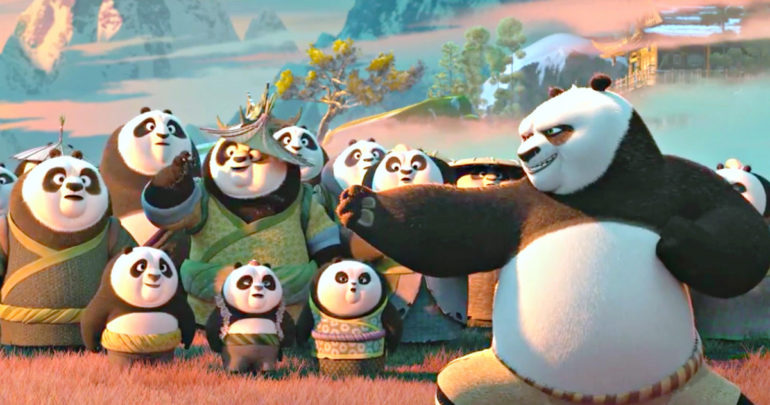In spite of Disney being the corporate giant of the animated film industry, Dreamworks Animation has proven itself to be just as capable of producing high-quality, entertaining features (although we have yet to see a film that provides the same tear-jerking effect that Disney and Pixar manage to pull off time and time again). With its output including Shrek, How to Train Your Dragon and Madagascar, Dreamworks have developed a dependable stable of successful franchises they can draw from. This includes Kung Fu Panda, a franchise whose first two films accumulated over $600m in worldwide box office receipts each, and inspired a successful Nickelodeon television show.
In Kung Fu Panda 3, the loveable, geeky and determined panda Po (voiced once more by Jack Black) returns to the big screen, continuing his training and mastering of the art of kung fu alongside the Furious Five – Tigress (Angelina Jolie), Mantis (Seth Rogen), Crane (David Cross), Monkey (Jackie Chan) and Viper (Lucy Liu). They train under the guidance of Master Shifu (Dustin Hoffman), who has decided that Po is ready to take his place as their teacher. However, Po does not feel he can step up to the role, and he is distracted from his responsibilities when his biological father Li Shan (Bryan Cranston, whose voice lends the character a warm paternal quality) returns, sparking conflict with Po’s adoptive father, Mr. Ping (James Hong). On top of all that, Kai (voiced by J.K. Simmons, so hot right now), the nemesis of Shifu’s old master Oogway (Randall Duk-Kim), has returned from the spirit world determined to take over the mortal realm by stealing every kung fu master’s ‘chi’ and defeating the dragon warrior, who is Po.
Kung Fu Panda 3 is replete with the same characters we know and love from the first films as well as some interesting new faces in Kai, Li Shan, and Mei Mei (Kate Hudson), a dancing panda with a crush on Po. The film also sees a new setting as our protagonist returns with Li Shan to his birthplace. The quaint village is full of pandas – baby pandas, pandas rolling down hills, little granny pandas, big, fluffy pandas, and pandas munching to their hearts’ content. The cute factor is overwhelming, yet irresistible. Additionally, the film’s impressive and colourful action choreography works excellently in 3D (and this coming from a reviewer who is really not a fan of the phenomenon at all), which will leave both adults and children stunned and enthralled.
While the film is not as laugh-out-loud funny as the first Kung Fu Panda, it is an improvement on Kung Fu Panda 2, which suffered some pacing issues and had a darker plot than its predecessor. It opts for a simpler, lighter and (literally) fluffier story, which works to its advantage. Those who haven’t seen the first two will be able to follow it quite easily, though of course a great deal of the pleasure that comes with sequels in seeing characters you are already familiar with embark on new adventures. However, Kung Fu Panda 3’s ending irrationally abandons the logic the film set up in earlier sequences, and it also suffers from that timeless issue with franchises that it is essentially a rehash of the same story – a new enemy enters and threatens the local town, and Po must overcome his self-doubt and learn new skills to battle and defeat the enemy. Entertaining as they are, once the three films are inevitably released in a box set collection, one will likely be unable to recall what happens in which film.

